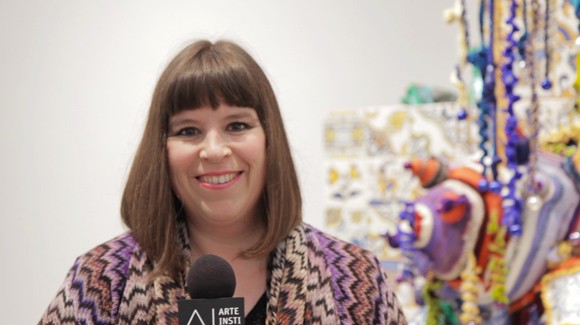
Joana Vasconcelos
The artist Joana Vasconcelos was in New York for the opening of the show “How To Tell The Future From The Past”.
The artist participates in the exihibition at Haunch of Venison gallery along with Yang Jiechang, Justin Mortimer, Patricia Piccinini and Eve Sussman.
On view until March 2nd, this group show examines the work of five artists who suggest the trajectory of humanity not as a continuous advancement, but as an endless return to a base nature.
Across painting, sculpture and video, the exhibiting artists present individuals as resourceful and sophisticated, yet incapable of fundamentally bettering themselves. The belief in an overarching human narrative destined for a promised goal has in the terms of postmodernity been understood as a fallacy. In spite of this, the desire for moral and intellectual improvement remains central to the idea of advanced society. This paradox is encapsulated in Freud’s essay “Civilization and its Discontents,” in which he characterizes civilization as “a tool we’ve created to protect ourselves from unhappiness, and yet, because it denies our most primitive instincts, it is the largest source of our unhappiness.”
How to Tell the Future from the Past uses time as the vehicle from which to analyze the dubiousness of humanity’s achievements. In the title work, Eve Sussman presents a three-channel video shot during a 72-hour train journey across the steppes of Central Asia. The train makes its way from barren to built-up environments, but the video plays simultaneously backwards and forwards across the three screens, undermining attempts to read logic into the evidence of human influence on the landscape. Similarly, Yang Jiechang merges the ancient and conservative tradition of Chinese ink drawing with shocking, contemporary themes while British painter Justin Mortimer creates contemporary history paintings using a conflicting range of source imagery taken from medical and war journals, the Internet and his own photographs.
Patricia Piccinini and Joana Vasconcelos both exhibit man-made materials and unnatural forms to suggest the unwieldy relationship between who we are and what we want. Piccinini examines humans’ complex relationship with technology. Her hyperrealist sculptures of hybrid animals and artificial creatures appear both primitive and highly advanced and provoke anxiety and allure. Vasconcelos incorporates everyday objects and textiles in readymades, which explore the role of traditional customs within a mechanized and technologically-advanced society.
Watch the interview with Joana Vasconcelos in New York at the opening of the show.

